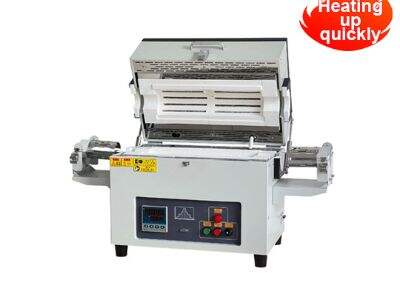For this purpose, one of the frequently used tools is the sintering furnace. But what is a sintering furnace and how it helps in grinding? This guide will help you understand sintering furnaces, their working principle, advantages, and that they can make you a better material grinder.
What is a Sintering Furnace?
Sintering furnace is a large machine used at a high temperature that sticks materials together. They are commonly used at production furnaces that make ceramics, metals, and other materials. A sintering furnace works by raising the temperature of material to a certain point. That high heat enables the tiny particles in the materials to fuse into a solid part. This process of pressing tiny particles together is known as sintering, and that's how the furnace got its name.
A sintering furnace alters material in many ways when they are heated. Some materials, for instance, may get stronger or expand when they warm up. Most industries would rely on sintering furnaces, and this is why.
What do we need Sintering Furnaces when grinding materials?
One of the benefits sintering furnaces have is helping to make material more uniform, consistent, but when grinding those materials. Instead, small particles may melt and combine together resulting in bigger pieces of well-formed and homogenous pieces more uniform than initial particles. As a result of being more uniform, they are easier to work with to give better output.
Sintering furnaces can also strengthen and make the materials more durable. This means that the materials will be less susceptible to wear and tear, an important consideration in manufacturing. The stronger the materials, the less likely they are to break or crack with time, thus saving both time and money.
Types of Sintering Furnaces
There are several types of sintering furnaces, but they all work essentially on the principle of holding materials at high temperatures. The varieties include the following:
Electrically Heated Furnaces: This heats through electric heat, and it is better suited for smaller batches of materials. They are easy to control and can be lit up pretty easily.
Gas-Fired Furnaces: These use gas burners to produce the heat. These are generally used for processing more quantities of materials, and they also attain higher temperatures than electrically heated furnaces.
Vacuum Furnaces: Such furnaces run inside a vacuum chamber. This is very priceless since it helps to steer clear of unwanted side reactions that occur during the sintering process. And at a vacuum, this effect is much better-and even the material bond stronger.
The main role of the sintering furnaces in the production process of high quality products is the grinding of material. They assist in ensuring the materials are in the same size and shape hence the final product is well levelled. Sintered parts are strong in strength hence there is a possibility of breaking fewer parts that translates to reduced wastages.
Material Grinding Evolution through Sintering Furnaces
They have revolutionized how the manufacturing industry works because they allow for the production of stronger materials. And they can also be exciting for changing how we grind materials. This means, of course, the end product is better quality as the materials tend to become more uniform when using sintering furnaces. Uniformity, of course, means everything is the same to a degree, which matters with things when it comes to ceramics and metal parts fitting together.
Sintering is supposed to make stronger materials that are less likely to break. That's especially critical because that means things that are made from these materials are going to last longer and work better. This allows tools and machinery made with sintered materials to endure more stress, resulting in superior performance and fewer repairs.
Sintering furnaces also aid in quickening and making the grinding process more effective. They help in producing bigger, more uniform particles that require less grinding so you can save time and energy with these furnaces. It lets you get done with work faster, which is pretty handy in a busy manufacturing setting. In addition, it also generates waste amounts, so it's great for the environment as well as for your wallet.
application instructions for Sintering Furnaces
Of course, it is a crucial step in master material grinding to learn how to operate sintering furnaces. To begin with is the selection of the right kind of furnace needed. For smaller quantities, electric-heated furnaces are appropriate, while larger batches require gas-fired furnaces. In specific applications where the pressure has to be lower in order to have the best possible results, vacuum furnaces are used.
The next thing you would require is the sintering temperature and time. For the materials that you are using and the result that you desire, the perfect temperature and time will be different. Some materials need higher temperatures and more time to achieve a proper bond. The balance is however the key to optimal results.
The sintering process is the final watch that one needs to maintain. The materials must be sintering properly and no problems in them, which may affect the final product. This is achieved by checking the materials periodically and looking for any temperature fluctuations. Observation of the process closely keeps one abreast of the problems that might arise, which will surely prevent the issues from arising too late and keeping the quality of the final product.
Conclusion
High temperature sintering furnace is basically doing the job and sintering the strength of material you want. Material grinding is somewhat delicate, and many factors that include what type of furnace to use, what temperature and time to set, and monitoring process all tell. Using the right tools and techniques allow you to develop top-quality products that can survive for quite a while. If you have an idea how sintering furnaces operate and how you can use them, you bring your advanced stage of material grinding to new dimensions!

 EN
EN
 AR
AR
 BG
BG
 CS
CS
 DA
DA
 NL
NL
 FI
FI
 FR
FR
 DE
DE
 EL
EL
 HI
HI
 IT
IT
 JA
JA
 KO
KO
 NO
NO
 PT
PT
 RO
RO
 RU
RU
 ES
ES
 SV
SV
 TL
TL
 ID
ID
 SR
SR
 VI
VI
 SQ
SQ
 HU
HU
 TH
TH
 TR
TR
 FA
FA
 MS
MS
 BE
BE
 IS
IS
 BN
BN
 LO
LO
 LA
LA
 MN
MN
 KK
KK
 UZ
UZ
 LB
LB
 XH
XH


